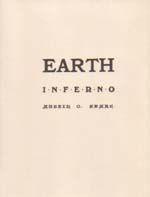
The Divine Comedy is an Italian narrative poem by Dante Alighieri, begun c. 1308 and completed around 1321, shortly before the author's death. It is widely considered the pre-eminent work in Italian literature and one of the greatest works of Western literature. The poem's imaginative vision of the afterlife is representative of the medieval worldview as it existed in the Western Church by the 14th century. It helped establish the Tuscan language, in which it is written, as the standardized Italian language. It is divided into three parts: Inferno, Purgatorio, and Paradiso.

In Greek mythology, Charon or Kharon is a psychopomp, the ferryman of the Greek underworld. He carries the souls of those who have been given funeral rites across the rivers Acheron and Styx, which separate the worlds of the living and the dead. Archaeology confirms that, in some burials, low-value coins known generically as Charon's obols were placed in, on, or near the mouth of the deceased, or next to the cremation urn containing their ashes. This has been taken to confirm that at least some aspects of Charon's mytheme are reflected in some Greek and Roman funeral practices, or else the coins function as a viaticum for the soul's journey. In Virgil's epic poem, Aeneid, the dead who could not pay the fee, and those who had received no funeral rites, had to wander the near shores of the Styx for one hundred years before they were allowed to cross the river. Charon also ferried the living mortals Heracles and Aeneas to the underworld and back again.

Gabriel Charles Dante Rossetti, generally known as Dante Gabriel Rossetti, was an English poet, illustrator, painter, translator, and member of the Rossetti family. He founded the Pre-Raphaelite Brotherhood in 1848 with William Holman Hunt and John Everett Millais. Rossetti inspired the next generation of artists and writers, William Morris and Edward Burne-Jones in particular. His work also influenced the European Symbolists and was a major precursor of the Aesthetic movement.

Austin Osman Spare was an English artist and occultist who worked as both a draughtsman and a painter. Influenced by symbolism and Art Nouveau, his art was known for its clear use of line, and its depiction of monstrous and sexual imagery. In an occult capacity, he developed magical techniques including automatic writing, automatic drawing and sigilization based on his theories of the relationship between the conscious and unconscious self.
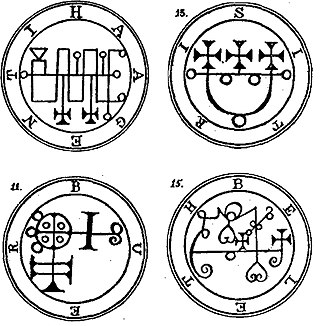
A sigil is a type of symbol used in magic. The term usually refers to a pictorial signature of a deity or spirit. In modern usage, especially in the context of chaos magic, a sigil refers to a symbolic representation of the practitioner's desired outcome.

Trevor Thomas Phillips was an English visual artist. He worked as a painter, printmaker and collagist.
Andrew D. Chumbley was an English practitioner and theorist of magic, and a writer, poet and artist. He was Magister of the UK-based magical group Cultus Sabbati.
Sandow Birk is an American visual artist from Los Angeles whose work deals mainly with contemporary American culture. Eight books have been published on his works and he has made two films. With an emphasis on social issues, his frequent themes have included inner city violence, graffiti, various political issues, travel, prisons, surfing and skateboarding. His projects are often elaborate and epic in scale, including a series on "The Leading Causes of Death in America" and the invasion and the second war in Iraq. He completed a hand-made illuminated manuscript version of the Qur'an, transcribing the English language text by hand in a personalized font based on graffiti, and illuminating the pages with scenes of contemporary American life.

The Divine Comedy has been a source of inspiration for artists, musicians, and authors since its appearance in the late 13th and early 14th centuries. Works are included here if they have been described by scholars as relating substantially in their structure or content to the Divine Comedy.
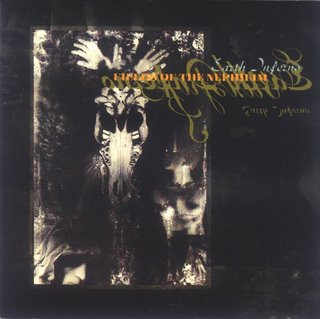
Earth Inferno is a mixed version of three live performances by Fields of the Nephilim which shares its name with a self-published book by occult artist Austin Osman Spare. The live venues used for the recordings were from the group's 1990 Sumerland tour at Wolverhampton Civic Hall, Brixton Academy and Hamburg Sportshalle. The record was released in April 1991 by Beggars Banquet Records and peaked at number 39 in UK album charts.

The Book of Pleasure (Self-Love): Psychology of Ecstasy is a chapbook written by artist-occultist Austin Osman Spare during 1909–1913 and self-published in 1913.
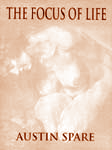
The Focus of Life, The Mutterings of AOS is a comprehensive treatise written and illustrated by Austin Osman Spare on key occult concepts he introduced in his previous writings.
The permissibility of depictions of Muhammad in Islam has been a contentious issue. Oral and written descriptions of Muhammad are readily accepted by all traditions of Islam, but there is disagreement about visual depictions. The Quran does not explicitly or implicitly forbid images of Muhammad. The ahadith present an ambiguous picture, but there are a few that have explicitly prohibited Muslims from creating visual depictions of human figures. It is agreed on all sides that there is no authentic visual tradition as to the appearance of Muhammad, although there are early legends of portraits of him, and written physical descriptions whose authenticity is often accepted.
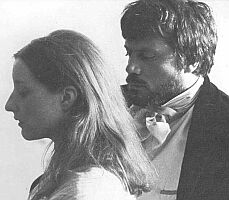
Dante's Inferno: The Private Life of Dante Gabriel Rossetti, Poet and Painter (1967) is a feature-length 35 mm film directed by Ken Russell and first screened on the BBC on 22 December 1967 as part of Omnibus. It quickly became a staple in cinemas in retrospectives of Russell's work. Using nonlinear narrative technique, it tells of the relationship between the 19th-century artist and poet Dante Gabriel Rossetti and his model, Elizabeth Siddal.

Francesca da Rimini and Paolo Malatesta appraised by Dante and Virgil is a composition painted in at least six very similar versions by Ary Scheffer between 1822 and 1855; all are in oils on canvas. The paintings show a scene from Dante's Inferno, of Dante and Virgil in the shadows to the right viewing the murdered lovers Francesca da Rimini and Paolo Malatesta in Hell. It "could be described as Scheffer's best work".

Paolo and Francesca da Rimini is a watercolour by British artist and poet Dante Gabriel Rossetti, painted in 1855 and now in Tate Britain.
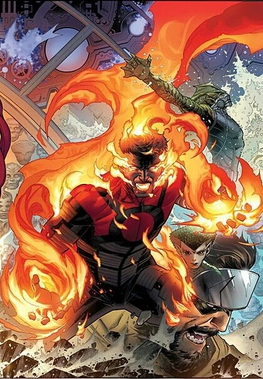
Inferno is a superhero appearing in American comic books published by Marvel Comics. Created by Charles Soule and Joe Madureira, the character first appeared in Inhuman #1.

The Divine Comedy Illustrated by Botticelli is a manuscript of the Divine Comedy by Dante, illustrated by 92 full-page pictures by Sandro Botticelli that are considered masterpieces and amongst the best works of the Renaissance painter. The images are mostly not taken beyond silverpoint drawings, many worked over in ink, but four pages are fully coloured. The manuscript eventually disappeared and most of it was rediscovered in the late nineteenth century, having been detected in the collection of the Duke of Hamilton by Gustav Friedrich Waagen, with a few other pages being found in the Vatican Library. Botticelli had earlier produced drawings, now lost, to be turned into engravings for a printed edition, although only the first nineteen of the hundred cantos were illustrated.
In chaos magic, gnosis or the gnostic state refers to an altered state of consciousness in which a person's mind is focused on only one point, thought, or goal and all other thoughts are thrust out. The gnostic state is used to bypass the "filter" of the conscious mind – something thought to be necessary for working most forms of magic.
Within the magical system of Austin Osman Spare, Kia is a mystical concept – a sort of universal consciousness or unity, similar to the Tao. The concept has been adopted by numerous other occultists, such as Kenneth Grant, and has been particularly influential on the chaos magic movement.
